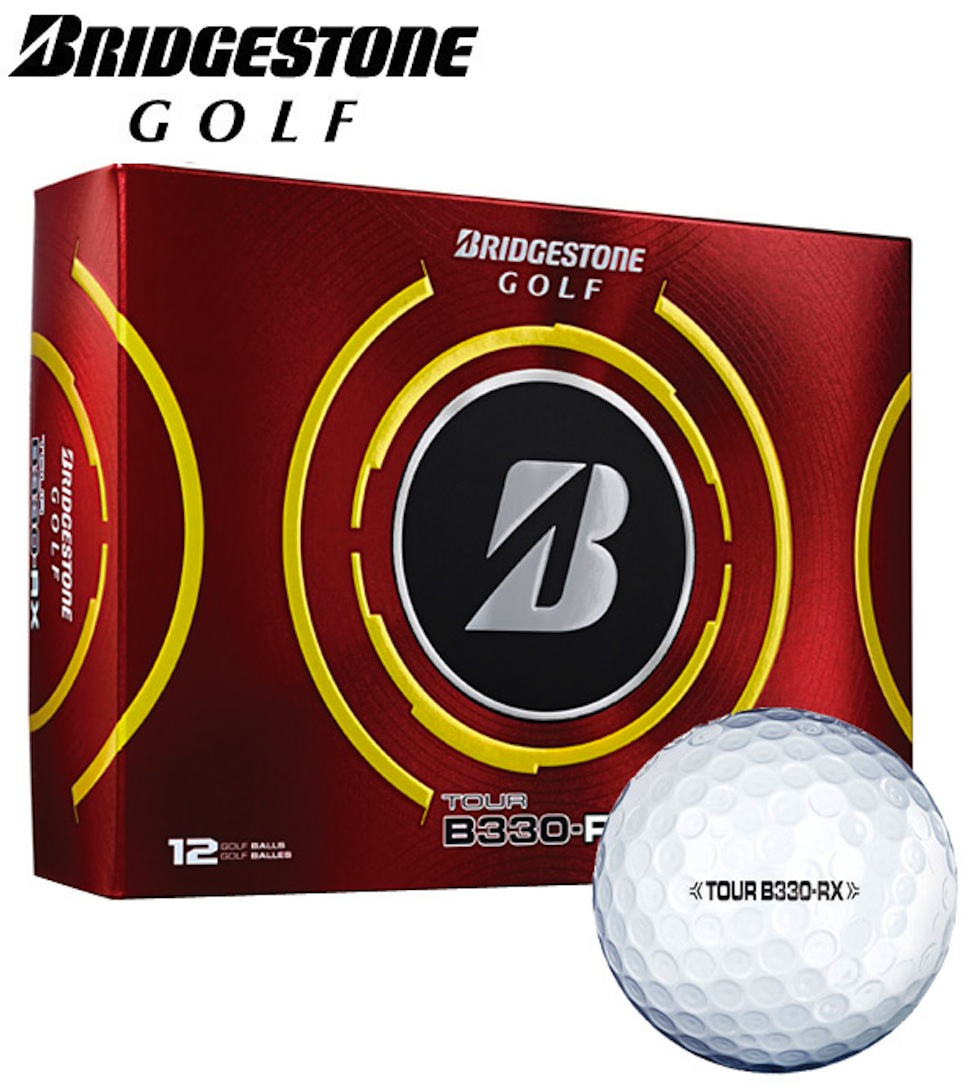 Many golfers might be surprised to know that, in terms of dollar market share, Bridgestone Golf has grown to become the number two golf ball in the industry. Bridgestone Golf began manufacturing its first golf balls on U.S. soil in 1990 under the Precept brand, and while it’s only been seven years since the Bridgestone Golf U.S. brand was launched, the company has been producing golf balls since 1935 and they are the number one golf ball producer in Japan.
Many golfers might be surprised to know that, in terms of dollar market share, Bridgestone Golf has grown to become the number two golf ball in the industry. Bridgestone Golf began manufacturing its first golf balls on U.S. soil in 1990 under the Precept brand, and while it’s only been seven years since the Bridgestone Golf U.S. brand was launched, the company has been producing golf balls since 1935 and they are the number one golf ball producer in Japan.
Bridgestone’s goal is to design a golf ball for every level of player. This is not an easy task since there are so many variations of golf swings. Getting fit for the right ball is just as important as finding the right shaft, lie angle, or grip size. Bridgestone is not only innovating golf ball technology but how golfers get fit for their ball. One thing is for certain, they aren’t afraid to compare their results against their numerous competitors.
For the past couple years, Bridgestone has had teams of ball fitting specialists provide free fitting sessions for golfers around the country. During these sessions, golfers see how the ball they currently play stacks up against a Bridgestone ball. I’m sure their competitors have taken notice. It also doesn’t hurt to have some notable staff players, Matt Kuchar, Brandt Snedeker, and Fred Couples, playing well and getting a lot of TV time.
Technology
There once was a time in the golf industry where the number one ball in golf was wound and constructed with a balata cover. Bridgestone was the first to develop a urethane three-piece solid-core golf ball, putting them on the map as a golf ball innovator. Urethane is an extra-soft, synthetic material that provides high-spin performance and greater durability than balata. In fact, urethane is softer than both surlyn and balata. These urethane-covered, solid core balls provided optimum spin and soft feel while providing a more consistent performance alternative to their wound balata-covered counterparts.
Bridgestone currently produces four models of the Tour B330 series. Each tailored to a specific category of golfer and their swing characteristics.
Tour B330 and Tour B330S
The line of Tour B330 and B330-S are made for players that swing above 105 MPH, at the tour level. Tour average is about 112 MPH. Both Tour B330 and Tour B330-S are four-piece balls. The biggest change to these balls from last year is that the cover is now 20% thinner. By shrinking the size of the cover Bridgestone is able to impart additional spin, which is good for control around the green. The Tour B330 is 6% softer and the TourB330-S is 13% softer than 2011’s design. The softer cover layer enhances green side control because of increased spin.
Since Bridgestone is thinning out the cover they also have to make the core of the golf ball larger. This new design is called the Gradational Compression Core. Two things happen when the core is enhanced, driver backspin is reduced and initial velocity is increased to maximize ball speed. All other things being equal, a higher ball speed translates into more distance.
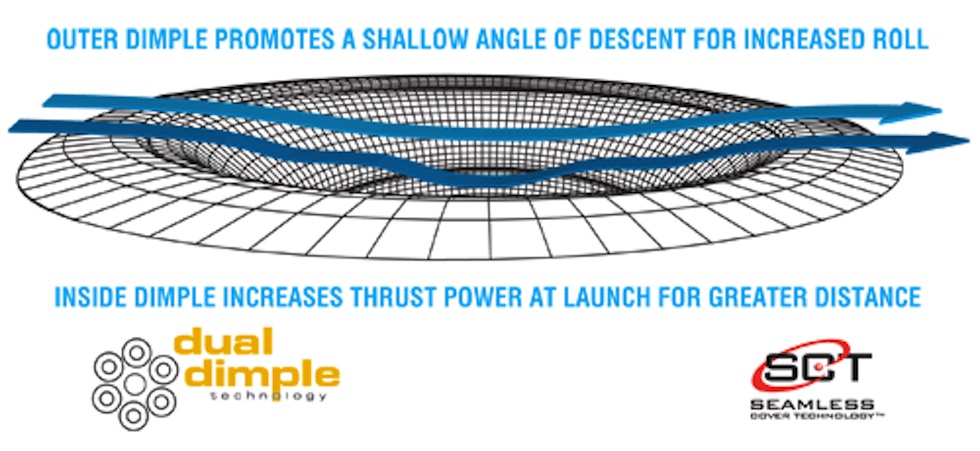
Dimples provide the lift needed to keep a ball airborne. Without them a golf ball’s performance would be severely restricted. New for 2012 is Bridgestone’s Dual Dimple Technology. This was introduced first in the E series ball last year. In general, golf balls with deeper dimples will tend to have a lower trajectory. Those with shallower dimples typically will generate a higher trajectory. Dual Dimple Technology creates the best of both worlds by improving the aerodynamics and performance of the ball in the wind.
Inside of each dimple pattern is an inner dimple. When a ball is struck, the highest amount of air flow is taking place. This is where the dual dimple design takes effect, the inner dimple takes that air flow, propels the ball upward and forces it to its highest point. The result is that the ball stays in the air longer. The outer dimple improves the landing trajectory. While other balls may tend to land at a steep angle, the outer dimple shallows the ball’s landing angle. With a more shallow decent the golf ball is encouraged to roll out further for great distance.
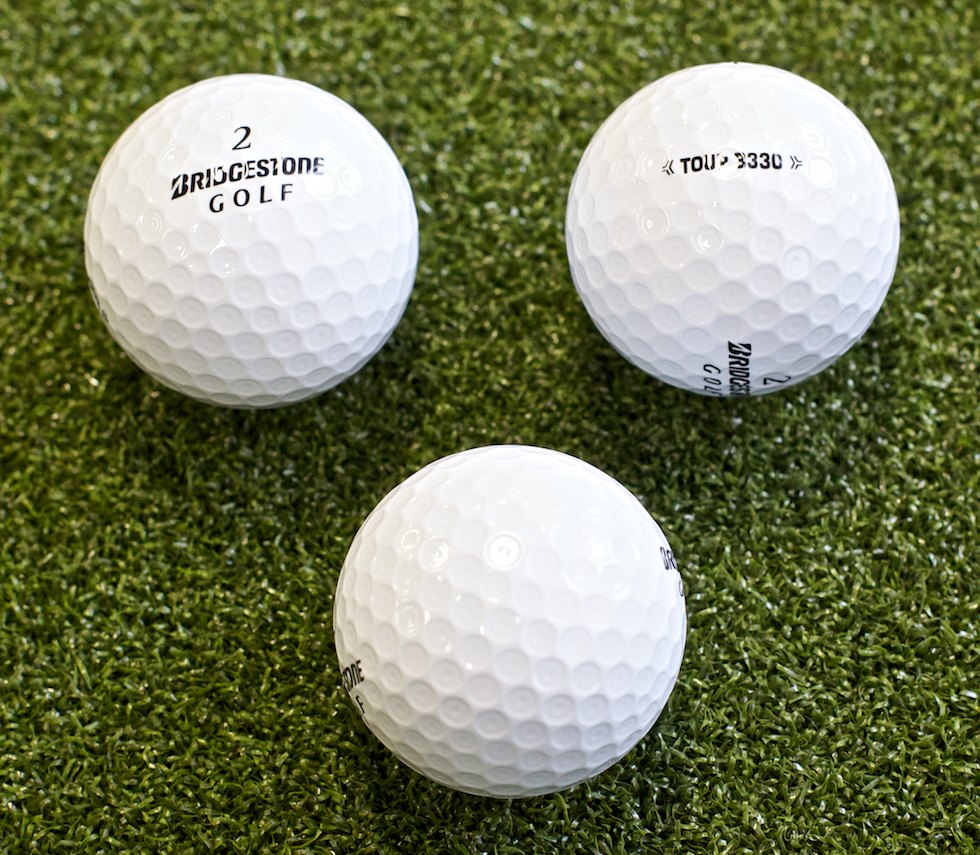
While the Tour B330 is a high performance golf ball designed to reduce driver spin, the Tour B330-S is the highest spinning green side performance ball they’ve ever produced. Players that swing over 105 MPH that are looking to maximize driver length should consider the B330 and players that need more spin or want more control into and around the greens should check out the B330-S. The new Tour B330 and Tour B330-S balls feature a street price of $44.99 per dozen.
President Cup Captains Nick Price and Fred Couples are currently using the Tour B330 line on tour.
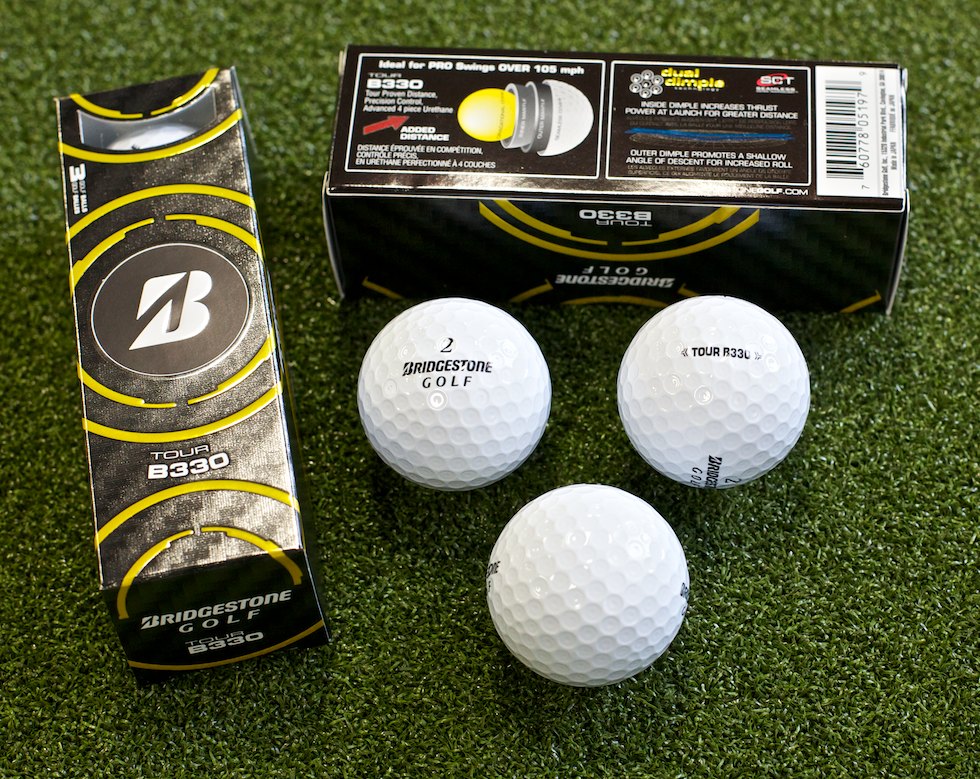
One of Bridgestone’s most innovative and oldest designs is the Seamless Cover Technology™, which is a proprietary manufacturing process that eliminates the straight part line and creates a non-uniform part line around the golf ball. The result is the most consistent golf ball in terms of accuracy, distance, and trajectory ever created. A seam on a golf ball is a straight line or “gap” where the dimples from the top half and the dimples from the bottom half of a golf ball do not meet through the compression molding process. A golf ball struck on the seam will not produce the same result because the asymmetrical dimple pattern significantly alters the aerodynamics of the golf ball and causes a wide range of flight characteristics. If you think about the core as the engine and the dimples as the wings, then a golf ball struck on the seam is not going to get the same “lift,” which translates into inconsistent distance and accuracy.
What Bridgestone balls do have is called a part line. A part line is created where the tool that encases the core separates after the injection molding process. The resulting line of material is then shaved off. Since this part line is created by the tooling process used in injection molding and does not affect the dimple pattern of the golf ball, the part line has a minimal effect on the performance of a golf ball.
B330-RX and B330-RXS
Bridgestone Golf tested thousands of golfers and found that no ball on the market could deliver great spin and performance on the green while also offering a softer compression that allowed moderate swing speed players the ability to compress the core in the same manner a high swing speed player does. As a result, Bridgestone Golf has developed the new Tour B330-RX and Tour R330-RXS.
These balls are made specifically for low handicappers who do not have tour-level swing speeds but want tour-level performance in their short game. With its new Gradational Compression Core, the B330-RX and B330-RXS provides maximum distance for moderate swing speed players, speeds of less than 105 MPH with a driver. Other golf ball manufacturers don’t produce a golf ball for this segment of player. The norm for the industry is to have a tour level, premium urethane moderate spin and low spin option. Then the next level down is a surlyn or fusablend cover which is not as soft as Urethane but is more cost effective.
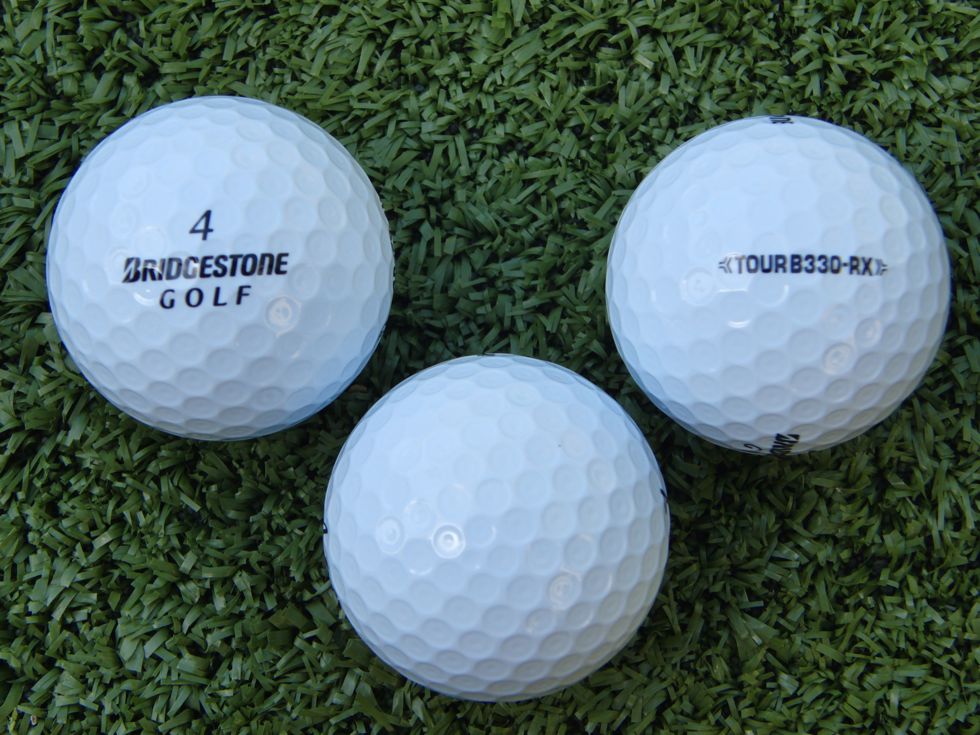
The Tour B330-RX and B330-RX-S are the same balls that Matt Kuchar and Fred Couples play except for two things. First, the core is softer which is more favorable for players with swing speeds of less than 105 MPH. The other difference is that it is a three piece ball because as you add additional layers the golf ball becomes harder to compress.
The biggest change from last year’s B330-RX series is the size of the inner mantle layer. The new inter mantle layer has been re-formulated to reduce driver spin. According to Bridgestone’s testing, 70% of golfers deal with excessive driver spin. With lower spin not only can you hit it farther but you have a chance of reducing dispersion. This results in longer and straighter shots.
The B330-RX and B330-RXS also feature the new Dual Dimple Technology for optimized aerodynamic performance. The cover’s smaller inner dimples increase thrust power at launch for greater distance while the larger outer dimples promote a shallow angle of descent for increased roll out on landing. The result of the improved performance at both takeoff and landing is greater overall distance performance and more consistency in flight. The new Tour B330-RX and Tour B330-RXS balls feature a street price of $44.99 per dozen.
Esthetics
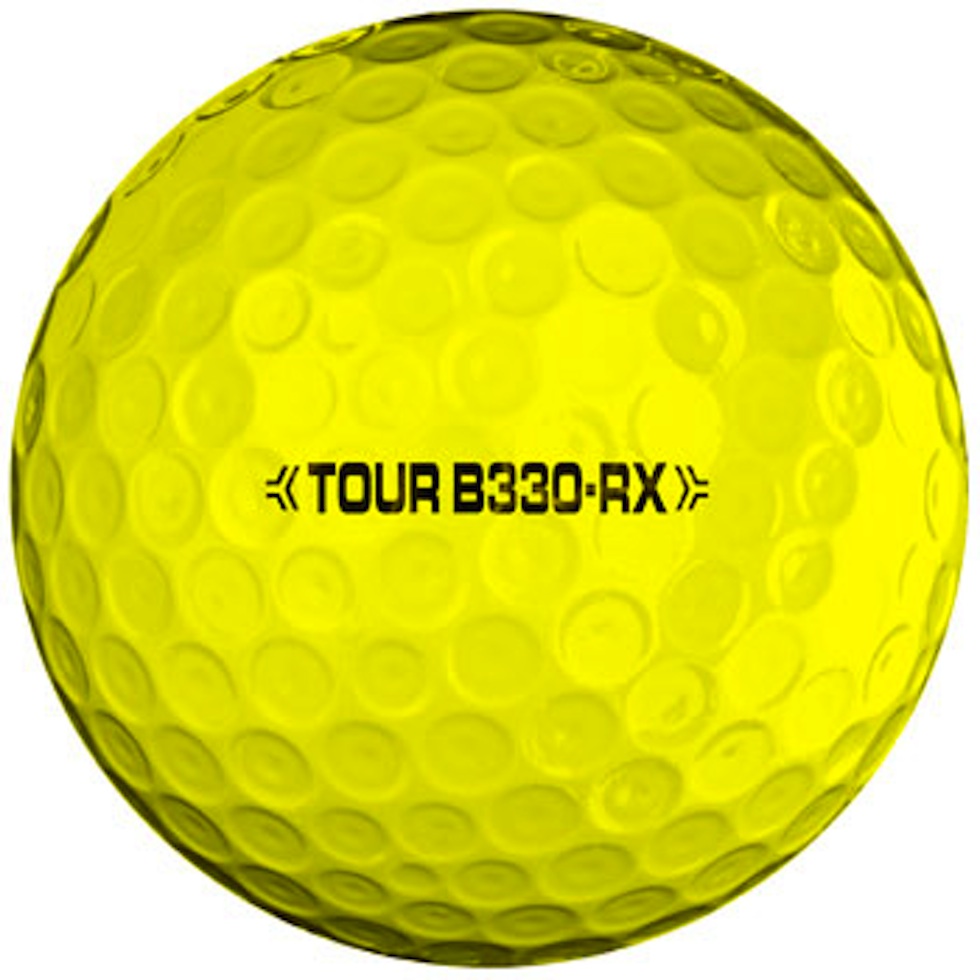 I don’t line up my putts with a line on the ball but if you do, the Tour B330 series has an alignment aid located perpendicular to the Bridgestone logo, where the script is closely spaced in bold font, almost creating the visual of a solid black line when putting.
I don’t line up my putts with a line on the ball but if you do, the Tour B330 series has an alignment aid located perpendicular to the Bridgestone logo, where the script is closely spaced in bold font, almost creating the visual of a solid black line when putting.
Both the RX and RXS are available in Optic Yellow, which Bridgestone says improves visibility. I didn’t test any balls in yellow, as I like white and yellow reminds me of range balls. I know there are a variety of colors you can get golf balls in Asia, but fortunately (for me) that craze hasn’t yet hit the U.S.!
Get Fit
Bridgestone is committed to making sure golfers get fit for the best ball for them through their Ball Fitting Challenge. Through optimizing your ball speed, launch angle, and spin rates, Bridgestone golf ball fitting specialists can guide you to a golf ball that will enhance your performance from tee to green. Bridgestone analyzes your shot data using a sophisticated computer system, the Science Eye Launch Monitor. During the fitting you will hit a series of shots with your driver, using your current golf ball. The high-speed cameras in the Science Eye Launch Monitor system will capture multiple measurements and use that data to calculate your specific launch characteristics. Based on your ball flight characteristics, the technician will either confirm that you are currently playing the best ball for you or recommend a Bridgestone ball that better suits your game. After hitting a series of shots with the recommended ball, you will be given a side-by-side comparison of all data, which includes your launch angle, spin rates, and distance with each ball.
At the PGA Show this year I was able to go through my very own Ball Fitting Challenge. I hit three drives with the ball I was currently playing, a “tour” ball. My spin was very low, 1700 RPM, an added reason for that was that I was hitting a Bridgestone J40 430 driver. This driver is known to be a spin killer. Even with my gamer driver the spin still would have been in the 2200-2300 RPM range. Then I hit three drives with the Tour B330-RXS because unfortunately my swing speed is under 105 MPH. The Bridgestone fitter also wanted me to get my spin numbers higher. The three drives I hit with the B330-RXS weren’t as solid as the first three but they ended up going the same distance. The softer cover and larger core was able to offset my lack of compression. Check out the video of my fitting above.
I applaud Bridgestone on how accessible and easy it is to find and complete a fitting. The only thing lacking is the consideration for testing players around the green. Another ball manufacturer prides itself on fitting from green to tee. It’s a longer process and one you’ll probably have to pay for. Hopefully Bridgestone will eventually expand their fitting process to include some short game shots.
Performance: Tour B330 and B330-S
(Erik J. Barzeski is adding a review of the B330/B330-S.)
With a swing speed around 110, I’ve always been comfortable playing the firmer ball. I generate enough backspin and launch the ball at a reasonable angle through the bag to stop the ball on the greens, so I’ve played the firmer of a company’s two balls (i.e. the Pro V1x over the Pro V1) since urethane covered golf balls first came on the market. To be honest, some of the softer covered “high-spin” premium balls spin way too much for me, both off the tee and around the greens, though the gap has closed in recent years to the point where most golf balls are fairly similar.
So of the two B330 balls, I prefer the B330 over the brother B330-S. I found that the B330 launched with essentially the same characteristics as the other longest premium balls I tried (it traveled farther than some of the other premium balls I tested), and launched and spun at about the same rates. Ball speed was consistently high, and carry distances were good.
Trackman tells me that my landing angle shallowed perhaps three or four degrees with the driver over other balls, though peak height was consistent with other balls at about 85 feet. I don’t know if 3° is enough to worry about, but it was consistent and speaks to the dual dimple design. I was concerned – and even asked at the PGA Show where I didn’t get an incredibly satisfying answer – whether the landing angle would change with the mid-irons. These clubs typically don’t have enough spin to “stop” the ball like a wedge does, and in the single-digit to plus handicap range, you don’t want “extra distance due to roll-out” with your mid-irons because the landing angle is shallowed out. Suffice to say I was happy that the dual dimples did not seem to adversely affect the landing angle or roll-out of the golf ball off any club above my 3W or hybrid. Great!
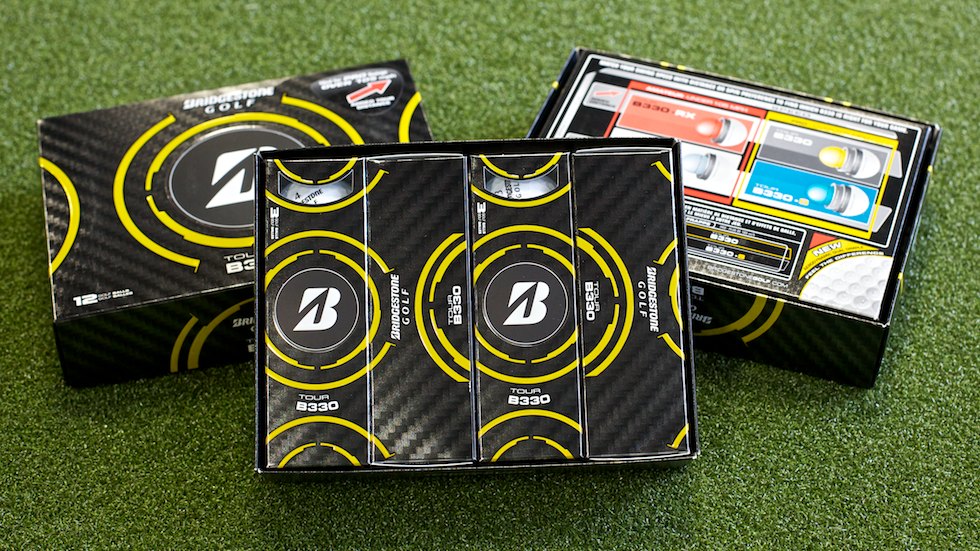
The ball felt lively off the clubface and performed admirably across the variety of shots I’ll hit. It never ballooned with the driver, even into the stiffest of breezes, and in fact wind play is one of the ball’s strong suits. This ball bores through a cross-wind and holds its line about as well as any ball I’ve ever played. I imagine the dimples have a bit to do with that, as well.
Around the greens the ball behaves as expected. From various lies – sand or grass – I can play every combination of height and spin and the ball reacts as I would expect. I never hit a shot that I expected to grab that ran out or a shot I expected to come off low that floated high, which is nice. The ball behaved exactly as expected around the greens.
What’s nice about the B330/B330-S is that the gap between them – the added softness and spin found in the B330-S – is not nearly so large that it’s unplayable. I could easily see myself playing the B330-S in tournaments or on days when the greens get really firm, for the added spin, with little to no adjustment in expectations for height or spin.
I’m really picky about my golf ball, and the B330 and B330-S are a one-two punch that sits squarely in a very short list of three golf balls I am happy to put into play.
Performance: Tour B330-RX and B330-RXS
I have never been a player to be loyal to a certain brand of golf ball. You name it and I’ve played it. Several years ago I would have categorized myself as a low launch, high spin player. I would always tend to play a ball that promoted itself to reduce spin. Now, after some major swing improvements, I tend to generate a bit less backspin than ideal and a higher launch. It’s been more of a mental adjustment to trust this fact by playing models that are softer will benefit my game.
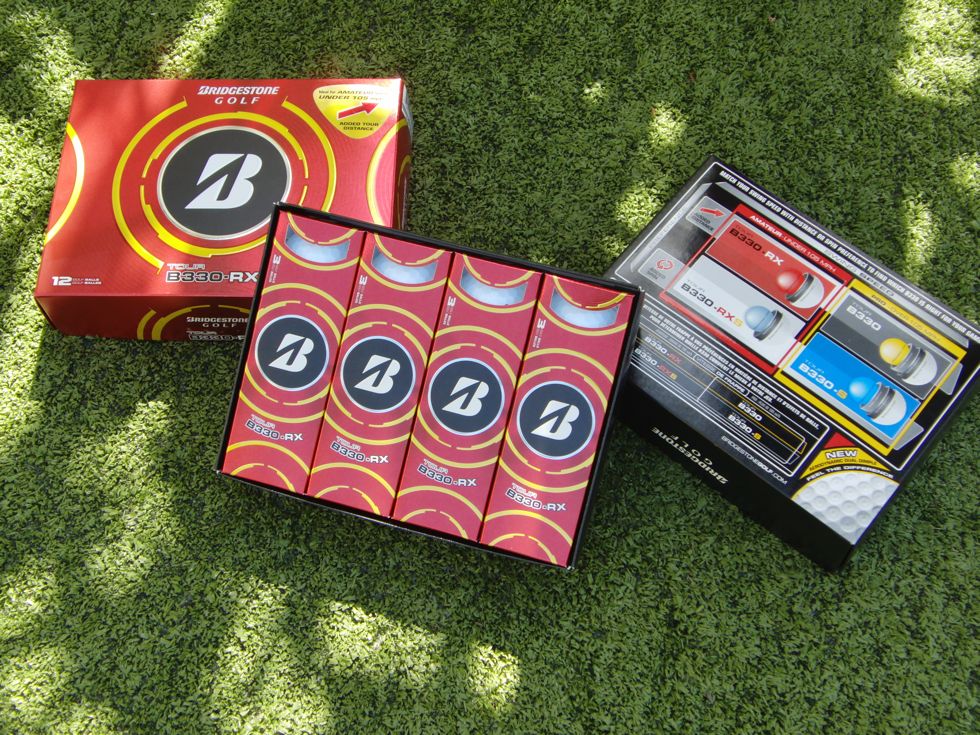
Putting these Bridgestone balls in play has been a lot of fun. I’ve been able to test the B330-RX and the B330-RXS. I’ve ended up preferring the B330-RX because I see a difference in run out with the driver and I don’t feel I’m sacrificing control around the greens. Like I said, I have played numerous kinds of balls in the past and to be painfully honest, I haven’t been one to notice huge differences between a ProV1 or a ProV1x. With the B330-RX, it’s a different experience. As advertised, the wind affects the golf ball’s flight less than previous balls I’ve played.
The greens at my home course can get firm and a shot that gets a bad bounce can end up in the deep rough just off the putting surface. It’s been nice to notice more shots hitting and stopping, giving myself more birdie putts. Even on days where I’m missing a lot of greens and I’m hitting more pitch shots from the rough, I can be more aggressive and predict how the ball is going to land on the green. I noticed the B330-RXS was slightly softer with pitches and sand shots but for me it wasn’t as reactive off the driver as the B330-RX.
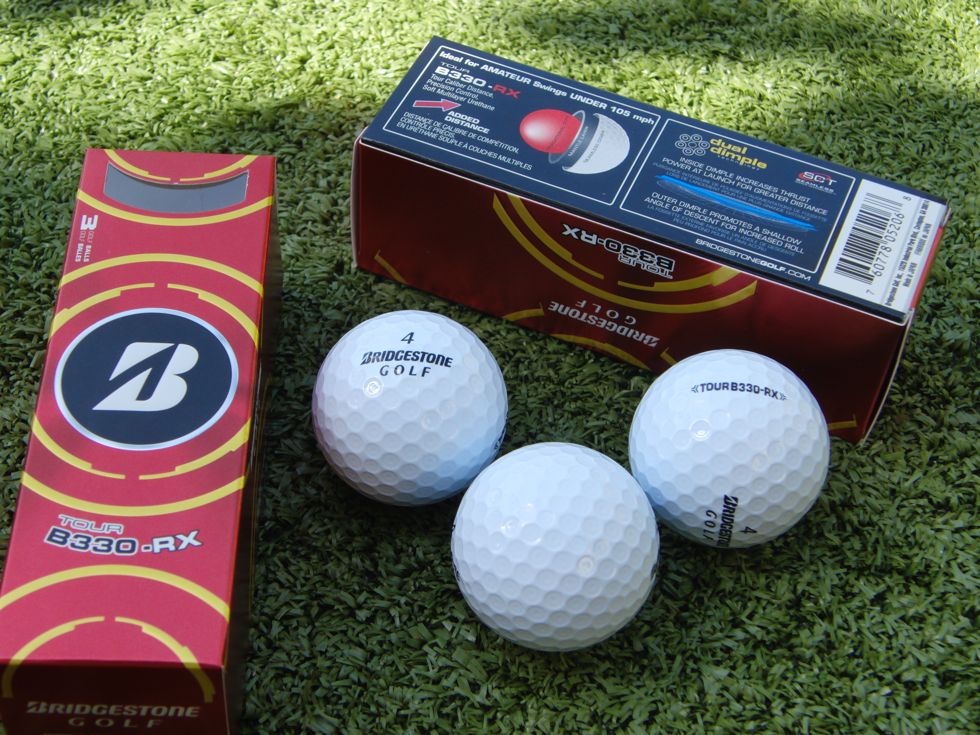
Durability
Bridgestone’s technological advancements really shine when it comes to the Tour B330 durability. There is slight visible wear after hitting iron and wedge shots but there isn’t any shearing, something I’ve experienced with other name brand golf balls. I even played the same ball for two straight rounds without any problems. It’s great to know that you don’t have to replace your ball every couple of holes because you’re worried how it might affect control or how the ball will roll on the putting green.
Conclusion
Choosing the right golf ball for your game can make a big difference in your performance on the golf course. Thanks to Bridgestone, that choice becomes a lot easier because there is a good chance they make a ball engineered for you. The Tour B330 and Tour B330-RX are geared towards those players who want to see some additional roll after hitting their drives. The difference is the B330 is for players that consistently swing their drivers over 105 MPH, while players that swing less than 105 MPH will be better suited for the B330-RX. Golfers that place a priority on short game control should consider the Tour B330-S and the B330-RXS. Like the RX, the RXS is designed for average swing speeds of players wanting to play a quality, tour-level ball.
If you currently play another brand of ball, I’d suggest picking up a sleeve of Tour B330 series balls and see for yourself how finding the right ball for your game can make a difference. Better yet find your nearest Ball Fitting Challenge where a Bridgestone fitting specialist will give you a sleeve of balls that will fit your needs after the fitting.
I have a concern about measurement of swing speed. I swing my driver 105-110 but I swing my irons like 70 or 80. Does anybody really swing their irons 105 consistently? Im asking because Im wondering where I would fall. Would I be over 105 or under 105? I swing different clubs with different levels of speed.
@Jim..as far as i know your swing speed is how fast you swing your driver and woods. Those are the clubs that are able to compress the inner core of the ball, and the difference in firmness of the inner core is what separates the 330/330-s and the 330rx/rxs
I quit reading when I got to the part that said “they are the number one golf ball producer in Japan.”
According to the Titleist website: Titleist golf balls are made in the U.S.
Enuff said!
I would think, based on commercials and what I’ve read online, when they are talking about swing speed they are talking about driver speed.
@Jim,
Thanks for asking that question. I’ve wondered about that for a while as well. It seems that ball fitting, club fitting and shaft fitting all seem to focus on the swing speed of the driver. I know I’m not swinging my 7 iron (and certainly not my SW) anywhere near my measured 105mph driver speed . Makes me wonder if we shouldn’t have different shaft flexes throughout our entire set???
Odd that we pay so much attention to a club we only hit twelve or thirteen times a round!
I also then have to disagree that driver is the only club that compresses the ball. I swing my irons very down (compressing) and I wonder if my swing speed with irons is so slow because with shorter irons my swing speed slows down after contact. I may just be rambling but I think I have decided that balls made for higher swing speeds are for me. Thank you
Guys, it’s simple.
With a wedge you don’t care as much about compressing the core. It’s more of a glancing blow (due to the loft), and you only want to send the ball 100 yards or so anyway.
With a driver you will compress the golf ball farther into the core. Not only is the blow more square (less loft) but you can swing a driver much faster than a sand wedge (lighter club, longer shaft).
Manufacturers are talking only about driver clubhead speed when they give out numbers like 105 MPH. That doesn’t mean if you swing 108 with a driver but less than 105 with every other club you have to choose a ball for < 105. It means the ball engineers realize that you swing slower with shorter clubs, so they engineer the layers you do compress – the outer layers – with the shorter clubs to react properly to carry far enough with the right levels of spin.
Is there much difference in performance between the 2011 and 2012 version on the RX? 20012 has dual dimple and thinner outer layer — does it make a difference?
I’m currently playing the 2011 RX. What should I expect to see in the 2012 version?
Bridgestone team showed up at my club on Wednesday, and gave me the Bridgestone Challenge. I compared my usual ball the TopFlite Gamer.v2 with the Bridgestone E6.
Driver = Razr Fit 9.5* head with Aldila RIP.D NV 60 gr. R shaft (low kick).
Both balls averaged 85.5 MPH clubhead speed, and had draw spin, which is how I was set up at address.
– E6 marginally higher on launch angle and ball velocity w/ +13 yds. carry
– Ideal sidespin = 2654; Gamer had +100 RPM backspin, E6 had -500 backspin. Gamer actually had -135 side spin compared to -165 for E6.
What does the “below ideal” backspin for the E6 mean in overall scheme of thing?
E6 billed as lower compression soft-feel distance ball. Will have to test out and see if E6 will check up some on partial wedge shots, or hit and run 30 feet past the pin. I have trouble with “distance balls” on half wedges more so than full iron approaches.
– Correction above: Ideal BACKSPIN = 2654.
WUTiger:
I recently have been playing these Bridgestone balls. I have tried both the E6 and the 330-S. For me the 330-S spun too much and i will be trying the 330 next. But for the E6 i was not able to get a whole lot of backspin on the ball. Not to say that it ran out a lot, but it didn’t back up for me even on full wedge shots. What i found is that the ball will hit and stop or hit and release a little (probably about 2-3 paces or so forward from the initial landing point down to about my 4i). If i
don’t love the feel of the 330 then i will be putting the e6 in my bag.
The longest player I’ve played a round with at my course uses the B330. A group of players who hit it about the same – but a shade shorter more often than not depending on the day – tend to use the ProV1x, Pro V1, Penta, B330, and B300S. Seems consistent with the advertizing at least wrt distance off the tee. None of the longest hitters (who I’ve played with – key point right there) were using a “distance ball”.